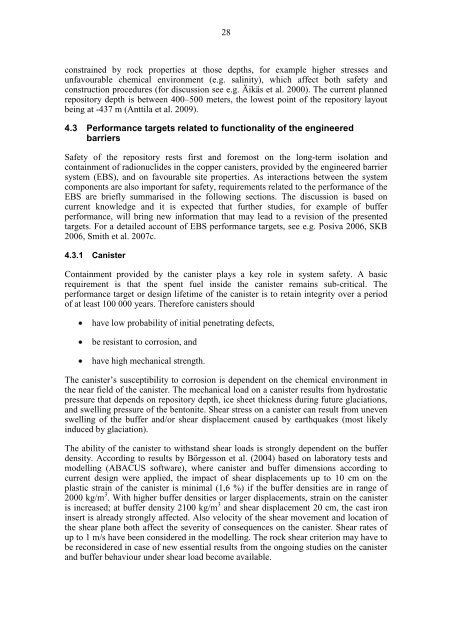RSC-Programme - Interim Report. Approach and Basis for - Posiva
RSC-Programme - Interim Report. Approach and Basis for - Posiva
RSC-Programme - Interim Report. Approach and Basis for - Posiva
Create successful ePaper yourself
Turn your PDF publications into a flip-book with our unique Google optimized e-Paper software.
28constrained by rock properties at those depths, <strong>for</strong> example higher stresses <strong>and</strong>unfavourable chemical environment (e.g. salinity), which affect both safety <strong>and</strong>construction procedures (<strong>for</strong> discussion see e.g. Äikäs et al. 2000). The current plannedrepository depth is between 400–500 meters, the lowest point of the repository layoutbeing at -437 m (Anttila et al. 2009).4.3 Per<strong>for</strong>mance targets related to functionality of the engineeredbarriersSafety of the repository rests first <strong>and</strong> <strong>for</strong>emost on the long-term isolation <strong>and</strong>containment of radionuclides in the copper canisters, provided by the engineered barriersystem (EBS), <strong>and</strong> on favourable site properties. As interactions between the systemcomponents are also important <strong>for</strong> safety, requirements related to the per<strong>for</strong>mance of theEBS are briefly summarised in the following sections. The discussion is based oncurrent knowledge <strong>and</strong> it is expected that further studies, <strong>for</strong> example of bufferper<strong>for</strong>mance, will bring new in<strong>for</strong>mation that may lead to a revision of the presentedtargets. For a detailed account of EBS per<strong>for</strong>mance targets, see e.g. <strong>Posiva</strong> 2006, SKB2006, Smith et al. 2007c.4.3.1 CanisterContainment provided by the canister plays a key role in system safety. A basicrequirement is that the spent fuel inside the canister remains sub-critical. Theper<strong>for</strong>mance target or design lifetime of the canister is to retain integrity over a periodof at least 100 000 years. There<strong>for</strong>e canisters shouldhave low probability of initial penetrating defects,be resistant to corrosion, <strong>and</strong>have high mechanical strength.The canister’s susceptibility to corrosion is dependent on the chemical environment inthe near field of the canister. The mechanical load on a canister results from hydrostaticpressure that depends on repository depth, ice sheet thickness during future glaciations,<strong>and</strong> swelling pressure of the bentonite. Shear stress on a canister can result from unevenswelling of the buffer <strong>and</strong>/or shear displacement caused by earthquakes (most likelyinduced by glaciation).The ability of the canister to withst<strong>and</strong> shear loads is strongly dependent on the bufferdensity. According to results by Börgesson et al. (2004) based on laboratory tests <strong>and</strong>modelling (ABACUS software), where canister <strong>and</strong> buffer dimensions according tocurrent design were applied, the impact of shear displacements up to 10 cm on theplastic strain of the canister is minimal (1,6 %) if the buffer densities are in range of2000 kg/m 3 . With higher buffer densities or larger displacements, strain on the canisteris increased; at buffer density 2100 kg/m 3 <strong>and</strong> shear displacement 20 cm, the cast ironinsert is already strongly affected. Also velocity of the shear movement <strong>and</strong> location ofthe shear plane both affect the severity of consequences on the canister. Shear rates ofup to 1 m/s have been considered in the modelling. The rock shear criterion may have tobe reconsidered in case of new essential results from the ongoing studies on the canister<strong>and</strong> buffer behaviour under shear load become available.
















